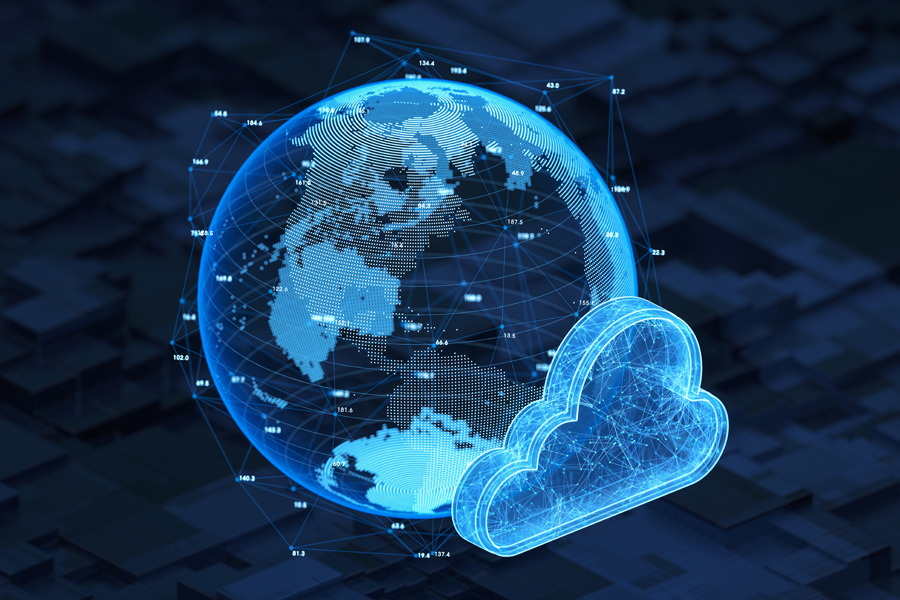
The smartphone was introduced 15 years or so ago. People’s lives have completely changed since they can look into the world with just a phone in their hands. It’s not just a phone after all, but is a means to understand the world and connect us to the world. What brought huge transformations like smartphones to companies?
C/L/O/U/D
Cloud 1.0 (2010-2020)
Exposition
Starting from the large general-purpose computers (mainframes, COBOL, and FORTRAN) in the 1980s, distributed processing became available with the performance enhancement of terminal machines in the 1990s. In the 2000s, fueled by increased network speed, companies were keen on building intranets. A little too keen. In 2006, when the cost for building infrastructure was snowballing every year and operation efficiency was dropping like a rock, Amazon dramatically came up with its cloud computing service.
Then, in the 2010s, finally the cloud computing era entered the world.
Amazon, Microsoft, Salesforce, and Google who all focused on cloud started to encroach on companies and the legacy market represented by leading companies, such as EMC, Dell, HPE, Oracle, and IBM, and the initial growth rate exceeded 65% when it was hitting its highest marks, which is a number greater than the driving speeds in cities. It was an amazing chase. Things went that way until 2017 when the major organizations removed “cloud” and started to include cloud-based AI, next-generation data security, virtual reality (VR), augmented reality (AR), IoT, platforms, etc., ahead of the next year’s ICT prospect.
Nevertheless, the “cloud” is still growing at a two-digit rate.
Around that time, the “Act on Cloud Computing” was announced in Korea (March 2015), which was the one and only cloud-related law in the world, and technologies, such as virtualization and distributed processing, were deployed for utilization as Presidential decrees. Now that I look back, it’s a little embarrassing, but it does give you an impression of being “nice.”
Let’s go back and take a look at the examples of cloud or cloud-based innovations in and out of the country.
A. SIEMENS
More than 85% of the process in 2020 was digitalized and automated, and about 1,000 IoT sensors were connected to all equipment. The digital twin technology was also applied to achieve a 0.0012% of product defect rate and respond flexibly to changes in design orders.
 Data source: SIEMENS
Data source: SIEMENS
B. LS Electric
The Cheongju factory was converted into a smart factory in 2015. All processes are conducted by robots and the Internet of Things, AI, and big data technology are applied, resulting in a 160% increase in production, 60% decrease in energy use, and a reduction of defect rate to 7 out of a million.
 Data source: The Panoramic View of LS Electric's Cheongju Smart Factory, LS Electric's
Data source: The Panoramic View of LS Electric's Cheongju Smart Factory, LS Electric's
C. Hwayo
Information technologies, such as the Internet of Things, cloud computing, and artificial intelligence, are applied to the production of distilled soju in the Yeoju factory along with the history management manufacturing execution systems (MES) to trace and manage all processes from the reception of raw material to the final product. This led to an 11% reduction in defects during production and a 6% increase in productivity by lowering production costs.
D. Hirotec (a global automotive component manufacturer)
The manual system inspection period has significantly dropped by predicting and preventing system errors through data collection, storage, and analysis with IoT, cloud computing, and machine learning in the product factories.
E. Korean Air
Korean Air officially announced its plan to convert 100% of its company-wide IT system to the public cloud and accomplished it in 3 years. It was the first 'big bang' transformation among the large global airlines, and is appraised as an exemplary case of a top-down cloud transformation from the administration to the organizational culture.
The first company-wide cloud transition of Korean Air raised expectations for the dramatic 2.0 era.
/ Big Cloud Era
Cloud 2.0 (2020- )
The second heyday of the cloud seems to have started in the public sector and finance in 2020.
The public sector started testing the waters beginning in about 2016, then realized it wasn’t just a “trend,” but a “paradigm,” and declared its 5-year plan for total cloud transformation in the public sector in 2019 (at a scale of 890 billion won). It opened the gate quite excessively, and leading domestic IT service companies couldn’t even keep up. All the digital vouchers, as well as Cloud as a Service and build-up services helped herald the era of the “Korean New Deal.” It was an unimaginable situation in the IT industry.
The 'small giant' cloud companies performed the roles of market leaders ahead of the New Deal without being intimidated by choosing partners from among the cloud service providers (CSP) of scale as the major managed service providers (MSP) of the public sector, and they led the medium to large IT companies with technology as if daring them to "follow me, if you can.”
Domestically, Megazone Cloud and Bespin Global are the leading service providers. Bespin Global has been registered in Gartner’s Magic Quadrant for five years since 2017. Although the aspects have changed a little now, would it be too much if I said it’s like their life has completely changed after passing an exam (like one for a certificate issued by global CSP) in the 80s or 90s? Anyways, their business model changed their business strategies and models for the leading IT companies, including KT, NAVER, NHN, and LG-CNS.
The finance remained calm to the end. Under the hem of the robe and the deep shade of the hat, they justified maintaining the formal frame as a security issue, but local traffic increased sharply (there was actually a system error at NH in 2011 that paralyzed the banking system for 3 days) and the consumers were just not like before. This is what is called the "general trend," and going through the COVID pandemic, they seemed resolved and have been taking more aggressive steps than any other field since the second half of 2021.
It had a great ripple effect.
Of course, foreign influence took up a great part, but since the central bank and global investment institutions started to recognize digital assets, such as cryptocurrencies, blockchain, fintech, virtual assets, NFT, central bank digital currencies (CBDC), and MyData, they've now gathered everything up in perfect order. Online transactions have been vitalized with AI, AI analysis data, and the open banking services without mid-processes.
Shinhan Bank, Lotte Card, Kookmin Bank, etc. They’ve been getting the public's attention and have become the talk of the town even more so than for their actual business.
Another big change is “manufacturing.” The big horses have begun to move. All the smart factories are gearing up with automation and intellectualization based on the verified cloud and 5G (specialized network). They benchmark the global manufacturers (Boeing, BMW, GE, etc.) who certainly already went ahead in the 1.0 era, and because of the property of lines, many companies go with the holistic approach rather than PoC.
Many cases show the aspects of big players in and out of the country when they introduce native cloud operating systems after building micro service architecture (MSA) or API instead of simple migration.
A. Boeing
They minimized the number of components with 3D printing technology in their factories in Utah, Sheffield, California, South Carolina, Washington, and Missouri, and applied digital twin technology to monitor production in real time and simulate optimization plans for the flow of material, leading to a 50% increase in productivity.
B. Schneider Electric
They applied IoT, big data and predictive analytics, augmented reality, remote monitoring, and predictive maintenance to their operation, and they achieved a simplified operation, higher efficiency, a reduction in energy consumption, and more than a 20% decrease in the equipment shutdown time.
C. GM
They’ve produced electric cars with the highest quality and optimized cost by realizing increased efficiency and productivity and minimizing safety issues through “Factory ZERO (zero crashes, zero emissions, and zero congestion)” where thousands of robots collaborate in a single assembly plant and technologies, such as 5G mobile network, artificial intelligence, 3D printing, IoT, cloud computing, and big data analysis are applied.
 Data source: GM
Data source: GM
D. Ericsson
They improved working conditions, such as shortening the component delivery time, reducing the risks of damage, or resolving issues with the component quality control process by applying 5G mobile communication, automated guided vehicles (AGV), augmented reality, and environmental sensors in their factories in Estonia.
There are about 2,000 smart factory suppliers domestically, and two cases from each of them will add up to over 4,000 cases. I hope the day will come soon when they're digitally equipped and get over the old-fashioned image.
Another difference from the DX cases is that it’s the managers at manufacturers, not the IT companies, who are leading the technologies in the cutting-edge technology transformation like XR, digital twin, and metaverse. IT only helps, and the directors in the virtual and augmented world are the companies themselves. You can’t deny the fact that holding the megaphone and taking the lead is completely different from the third industrial revolution (online transactions and internet).
It should have something to do with how the names of departments in companies that drive digital transformation are now called “innovation,” “smart,” “digital,” or even literally by the purposes themselves, such as “e-commerce,” “smart factory,” or “data strategy” when just using names like “information” or “IT” used to be the mainstream.
The recent battle for supremacy between the US and China was about “technology” (=data =money), and the current Russia-Ukraine war and sustainable management centering around ESG are adding to the risks of supply chain unpredictability. Therefore, the reshoring boom and ‘my country first' attitude around the world are shifting toward the region value chains (RVC) instead of the global value chains (GVC), and the cloud is not free from everything, including the shameful situation of recent “increased demands for on-premises solutions,” so it’s hard to say for sure if cloud can complete the missions of sharing, sourcing, and creating additional value.
In fact, the term “cloud” was first used by the marketing executive George Favaloro, and an engineer, Sean O’Sullivan, at Compaq in 1996. Their concept was similar to the current cloud vision, and they even tried to make a business out of it, but unfortunately, Compaq collapsed then, so they couldn’t even try it before an end was put to it. There’s a long story behind Amazon using the term “cloud” for their product EC2, and the term was popularized over time.
If Compaq didn’t go out of business and made it to the market somehow, the world would be quite different from how it is now.
▶ The content is protected by the copyright law and the copyright belongs to the author.
▶ The content is prohibited to copy or quote without the author's permission.

Market Insight Group, Samsung SDS
